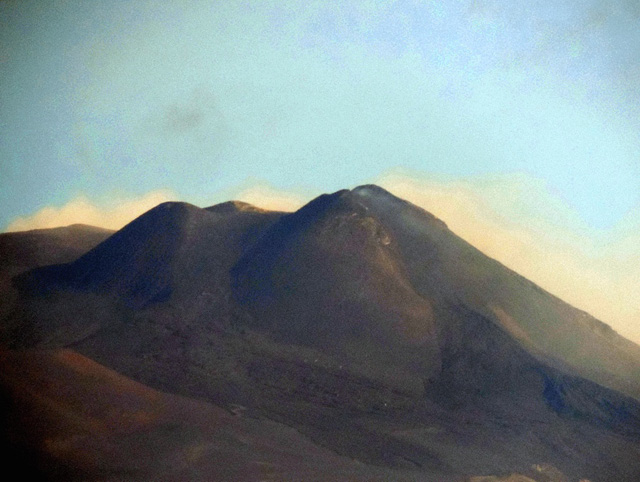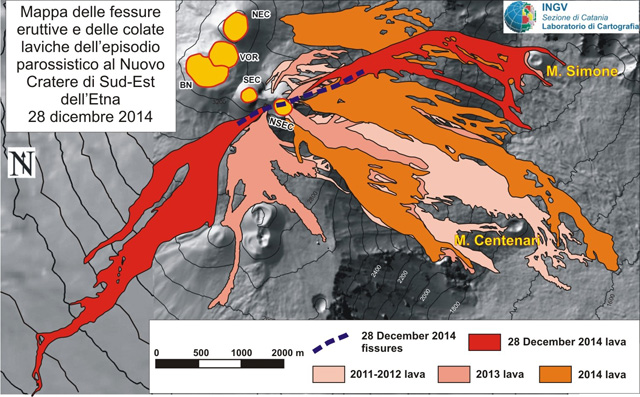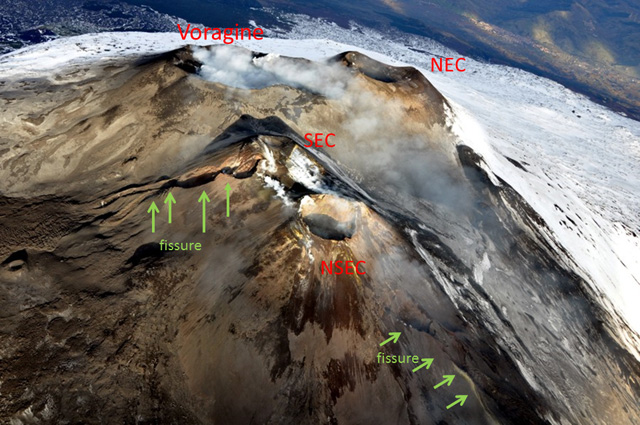Report on Etna (Italy) — February 2015
Bulletin of the Global Volcanism Network, vol. 40, no. 2 (February 2015)
Managing Editor: Richard Wunderman.
Etna (Italy) Strombolian eruptions, ash emissions, and new effusive vents through February 2015
Please cite this report as:
Global Volcanism Program, 2015. Report on Etna (Italy) (Wunderman, R., ed.). Bulletin of the Global Volcanism Network, 40:2. Smithsonian Institution. https://doi.org/10.5479/si.GVP.BGVN201502-211060
Etna
Italy
37.748°N, 14.999°E; summit elev. 3357 m
All times are local (unless otherwise noted)
Our last report (BGVN 39:11) covered activity at Etna through 13 June 2014, which consisted primarily of ongoing emissions of E-directed lavas from a vent area on the lower E flank of the New South East Crater (NSEC). This report, summarizing first-hand accounts by the Istituto Nazionale di Geofisica e Vulcanologia (INGV-Catania), covers the subsequent interval from 14 June 2014 through 2 February 2015. INGV described several eruptive episodes, including strombolian eruptions, ash emissions, and the appearance of new effusive vents at the E base of the North East Cone (NEC) and on the high E flank of the NSEC cone.
Activity during June-December 2014. On 14 June a new eruptive episode began within the NSEC, with near-continuous strombolian explosions and lava fountaining. Fine ash emissions were concurrent with lava that began to overflow the edge of the South East Crater (SEC), forming a flow that continued downhill on the W wall of Valle del Bove. During the morning of 15 June the overflowing lava followed the fissure that had been formed on 28 November 2013. Explosive activity occurred from three vents inside the crater. A spatter cone also formed in the NSEC's E sector, partially filling the fissure formed on the high NE flank during eruptions of late December 2013, and January–March 2014. During 14-15 June tremor increased sharply and remained moderately high until 18 June, when it returned to normal levels.
INGV noted that this lively strombolian activity over the course of four days was similar to the episode of effusive lava emissions observed during 14-16 and 19-31 December 2013 in terms of duration and intensity.
After images of a thermal anomaly in webcam images from Monte Cagliato, located on the E flank of Etna, a new, small fissure (tens of meters long) at the E base of the North East Crater (NEC) was observed by INGV Etna observatory personnel during 5-6 July. The vent was located between 3,015 and 3,025 m elevation. Weak spattering from this vent fed a lava flow that extended ~100 m within the saddle of the NSEC and SEC cones. Weak and sporadic strombolian explosions and small ash emissions were observed during 6-7 July from NSEC, but by 11 July this activity had ceased. Activity from the new fissure continued through 11 July with frequent strombolian explosions that were audible in nearby towns. The lava flow diverged; the longer of the two branches extended ~1.5 km, reaching the bottom of Valle del Leone.
On the morning of 25 July about 1114 local time, a new eruptive vent opened near the same eruptive fissure. This new vent ("25 July vent"), located at a distance of about 150-200 m to the N of the one from 5 July, was a source of strombolian explosions, accompanied at times by modest quantities of ash. This activity continued through 31 July. The strombolian explosions occurred at intervals of about 2-5 seconds and were often accompanied by visible compression waves ("flashing arcs") and audible rumblings up to a few tens of meters away, mostly in the E and NE sectors of the volcano. As previously observed, for example during the paroxysmal episode at the NSEC during 14-16 December 2013, the rumblings were interpreted as the result of explosions of gas bubbles inside the eruptive vent. Emissions of bombs and scoria occasionally rose 200 m high and fell within a few hundred meter radius around the vent. In a few instances, the explosions were accompanied by small quantities of ash. The lava flows, which had reached ~1.8 km during the preceding week, (halting on the saddle between the Valle del Leone and the Valle del Bove), had in the recent days overlapped the earlier ones, with active fronts at least 1 km from the effusive vent.
On 9 August INGV reported a strong decrease in volcanic tremor. From the 25 July vent, there began a gradual increase in the ash emissions that formed an ash plume, which rose to 1 km above the vent area and renewed strong strombolian activity in the evening. Strombolian activity increased at NSEC and was accompanied by small emissions of black ash that remained within the crater.
With the intensification of activity at the NSEC, the eruptive activity at the E flank of the NEC diminished. At 0645 on 9 August an effusive vent opened on the high E flank of the NSEC cone, which caused a small landslide and emitted a lava flow that after an hour had reached the E base of the cone. During the first 24 hours of activity, a small pyroclastic cone in the W portion of the NSEC summit appeared, increasing the height of the NSEC structure that began to grow in 2011. On 13 August INGV reported continued strombolian explosions, accompanied by modest emissions of ash and lava from a single vent on the high E flank of the NSEC. The lava flows emitted from the effusive vent to the E had almost ceased to advance the evening before, but two new branches were overlapping the earlier flow. The longest flow changed direction to later descend about 3 km NE toward Monte Simone. INGV reported that the eruption at NSEC had ended on 15 August and that the lava flow activity had ceased by 16 August (figure 151).
Beginning in the afternoon of 7 October through 16 October the NSEC produced weak and intermittent explosive activity; small ash puffs were rapidly dispersed by the wind. During some nights small strombolian explosions ejected incandescent material a few tens of meters above the crater rim.
Starting at 1850 on 28 December the NSEC produced a short but intense eruption characterized by lava fountains, lava flows, and an ash plume that drifted E, and caused ash and lapilli fall in the nearby towns of Milo, Fornazzo, Sant'Alfio, and Giarre. It was the first typically "paroxysmal" event at the NSEC since 2 December 2013. Inclement weather prevented observations of the summit area, so the erupting crater was not identifiable. Two lava flows traveled E and NE, towards the Valle del Bove. Tremor began to decrease at 2030, and indicated that the eruption was over at 2200 (figure 152).
On 29 December, cameras viewing Etna recorded small ash emissions from the NSEC and persistent glow from the saddle between the SEC and NSEC cones at dusk. INGV indicated that this paroxysmal episode occurred at a series of eruptive vents along a NE-SW fissure that cut across the NSEC and the southern flank of the old SEC. From the two extremities of this fissure lava flows emerged, traveling SW toward the area of Milia-Galvarina and NW toward the northern part of the Valle del Bove near Monte Simone, reaching lengths of about 4.5 and 3.3 km, respectively (figure 152).
Activity during January 2015. During the night on 1 and 2 January, cameras recorded intermittent flashes from Voragine Crater (one of four summit craters), indicating strombolian activity there for the first time in nearly two years. At 0730 on 2 January explosions at NSEC generated ash plumes that drifted SW. Emissions ejected pyroclastic materials up to ~150 m above the crater rim, which intensified during the evening of 3 January.
At night during 6-7 January the frequency of strombolian explosions at the Voragine Crater decreased; however, some of the explosions ejected incandescent pyroclastic material outside of the crater and onto the W and SW flanks. On 7 January many of the small explosions generated brown ash plumes that rose a few hundred meters above Etna's summit and quickly dissipated. Strombolian activity increased on 8 January, possibly from two vents within the crater. Pyroclastic material continued to be ejected out of the crater. Early on 9 January strombolian activity again decreased and gave way to ash emissions that rose several hundred meters. During the evening on the same day some ash emissions were accompanied by incandescent pyroclastic material that at times fell on the external flanks of the central summit. Ash emissions continued the next morning, decreased, and had almost completely ceased by late morning. Ash emissions rapidly resumed in the afternoon and were sometimes accompanied by strombolian explosions. During the morning of 13 January, new ash emissions began at the Voragine. For some hours, these emissions were continuous, but successively diminished in the afternoon to every 5-10 minutes. Marco Neri, of the INGV- Osservatorio Etneo, during a helicopter overflight on 14 January, captured a clear view of these emissions and of the summit crater area (figure 153).
In the evening on 14 January weak strombolian activity was recorded at the Voragine Crater and NEC. The next day, occasionally pulsating ash emissions rose from the NEC and drifted SE. Ash emissions continued through 17 January; cloud cover prevented observations of the summit area on 18 January.
A new eruptive episode began on 31 January and continued through the morning of 2 February. Poor meteorological conditions prevented views of the summit area during the first 36 hours of the eruption. During improved viewing conditions on the evening of 1 February, volcanologists observed lively strombolian activity from a single vent in the saddle between the SEC and NSEC cones. Explosions occurred every few seconds and ejected incandescent bombs 200 m high, which fell on the S flank of the SEC. At the same time, from a vent at the southern base SEC cone corresponding to the lowest part of the SE eruptive fissure from 28 December, a lava flow issued that traveled 2 km S, dividing into two branches. At dawn on 2 February the strombolian activity produced a dense ash cloud that drifted E. At about 0750 emissions stopped, and volcanic tremor suddenly decreased.
Geological Summary. Mount Etna, towering above Catania on the island of Sicily, has one of the world's longest documented records of volcanism, dating back to 1500 BCE. Historical lava flows of basaltic composition cover much of the surface of this massive volcano, whose edifice is the highest and most voluminous in Italy. The Mongibello stratovolcano, truncated by several small calderas, was constructed during the late Pleistocene and Holocene over an older shield volcano. The most prominent morphological feature of Etna is the Valle del Bove, a 5 x 10 km caldera open to the east. Two styles of eruptive activity typically occur, sometimes simultaneously. Persistent explosive eruptions, sometimes with minor lava emissions, take place from one or more summit craters. Flank vents, typically with higher effusion rates, are less frequently active and originate from fissures that open progressively downward from near the summit (usually accompanied by Strombolian eruptions at the upper end). Cinder cones are commonly constructed over the vents of lower-flank lava flows. Lava flows extend to the foot of the volcano on all sides and have reached the sea over a broad area on the SE flank.
Information Contacts: Istituto Nazionale di Geofisica e Vulcanologia (INGV), Sezione di Catania, Piazza Roma 2, 95123 Catania, Italy (URL: http://www.ct.ingv.it/).




